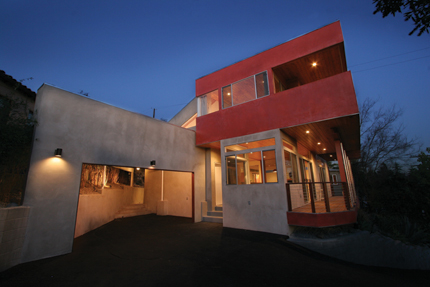
While considered brave these days, the idea of flipping a house was quite normal just a few years ago when architect Jeremy Levine purchased a residential property in Eagle Rock with a few other investors.
|
The house’s red clay motif continues in the bathroom.
|
The original 1,100-square-foot home, set atop a hillside, had the potential for a view of the Griffith Observatory in nearby Los Feliz. Levine utilized this focal point as a springboard for creating his own version of an observatory: a red stucco box cantilevering off the hill via a steel structure slipped beneath the slab of the existing home. This box encloses the master suite, its partially glazed exterior wall inset from the semi-enclosed deck, framing a panorama of the city beyond.
Every ground-floor room opens into a garden, a connection beween indoor and out that is typical of Levine’s California designs. Meanwhile, green elements can be found throughout. The exterior decks are Mangaris, a rich-colored wood Levine obtained from overstock. The interior floors are a light-beige Turkish limestone that’s soft under bare feet. Interior doors and exposed beams are made of recycled wood from the old ceiling, as are some of the chairs.
Levine not only likes the money he saved by avoiding dumping fees, but he also likes the connection between the old and new. “The old wood looks beautiful and you can see the history in the doors and furniture we created,” he said.
On the south side, horizontal slatted sliding screens shield the house from the sun. Levine designed them to be simple, hanging 4-foot-by-8-foot screens from hardware welded onto the steel beams. The home also employs passive cooling through thermal chimneys. A bamboo garden courtyard in the center of the residence mitigates heat in the living spaces, while a staircase leading to the master suite pulls the warm air up and the cool air down. Clerestory windows provide daylighting and allow plenty of light to pass between rooms.
Photovoltaic panels line the rooftop of the lower level, providing all of the home’s energy, and a rainwater harvesting system collects enough water from the roof to irrigate the property’s fruit trees. Gray water from the bathroom sinks and showers runs to a constructed wetlands area.
Another detail Levine added was shelving. Using 2-inch-by-10-inch framing, he created thicker walls with openings that allow light to pass through and built-in bookcases. “It makes the house appear larger and gives the house additional functionality,” said Levine.
The South Eagle Rock home was sold over three months before construction was completed. According to Levine, the project was profitable because his firm filled a niche that didn’t exist in the area. “We had no competition,” said Levine. “There wasn’t another green house in the area on the market.”